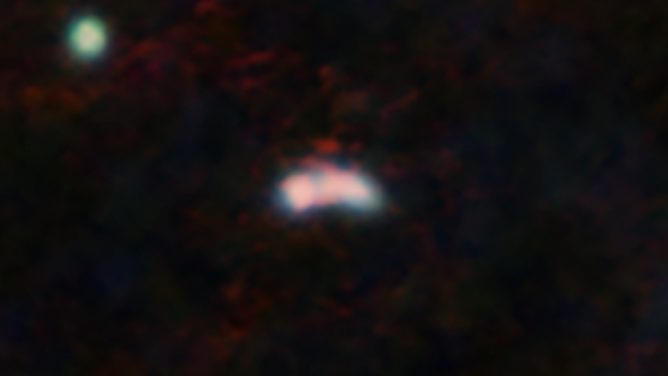The Atacama Large Millimeter/submillimeter Array (ALMA) has successfully tested an antenna in the most extended configuration of the array yet, producing the longest baseline ever achieved by ALMA. This advance became possible once the first of ALMA’s three extended arms was successfully powered up for the first time, and opens up the possibility of greatly extending ALMA’s capabilities. With longer baselines, the ability of a radio telescope to see fine detail increases, allowing astronomers to uncover much more information about objects observed in the Universe.
Figure 1. The current status of the ALMA Array Operations Site (5000 m above sea level). The array center is seen in the center of the picture.
Credit: ALMA (ESO/NAOJ/NRAO)/ Sergio Otarola
Lore, one of ALMA’s two tailor-made antenna transporters, made its first journey along the Pampa la Bola arm and for the first time relocated an antenna to a position seven kilometers away from its furthest neighbour. This marks a major new technical achievement in the Atacama Desert in Chile, at more than 5000 metres above sea level. This new baseline is more than four times longer than is currently available to the ALMA scientific community, and tests of even longer baselines are in progress.
Pampa la Bola is the place where Japanese researchers planned to build the Large Millimeter and Submillimeter Array (LMSA) in 1990s, one of the roots of the current international ALMA project. Now two Japanese radio telescopes are installed here; the Atacama Submillimeter Telescope Experiment (ASTE) operated by NAOJ Chile Observatory and the NANTEN2 telescope operated by the Nagoya University. Both telescopes targets to observe submillimeter-wave from star forming regions, galaxies, and distant universe.
Figure 2. Current antenna locations overlaid on the satellite image. The antenna locations are indicated with the black antenna icons, whereas the antenna pads are shown in gray circles. We can se three arms extending to north-east, south-east, and west.
Catherine Vlahakis, Lead Program Scientist for the ALMA Long Baseline Campaign says that: “successfully powering up an antenna for the first time over these long distances marks an important technical step towards increasing ALMA’s ability to see objects in the Universe in fine detail”.
Ed Fomalont, Lead Scientist for the ALMA Long Baseline Campaign, explains that “the combination of the signals from the antennas produces patterns called fringes. The fringes measured from the antenna seven kilometres away were as pure and strong as will be needed to obtain high quality images when additional antennas are moved to these long baselines.”
Catherine Vlahakis, adds that “this is the first step in a process of moving several antennas out to these longer distances. Once the rest of the antennas are also in place we will be able to begin test observations of astronomical objects at higher angular resolution, and therefore in more exquisite detail, than ALMA has yet achieved.”
Observations that will further test baselines as long as nearly 11 kilometers will continue over the next two months. If all goes as intended, this process will provide ALMA astronomers with the knowledge needed to offer long-baseline observations to the scientific community.
The photo below is the 12-m antenna installed in Pampa la Bola. ASTE and NANTEN2 are seen in the left.
Credit: ALMA (ESO/NAOJ/NRAO), E. Ormeño










